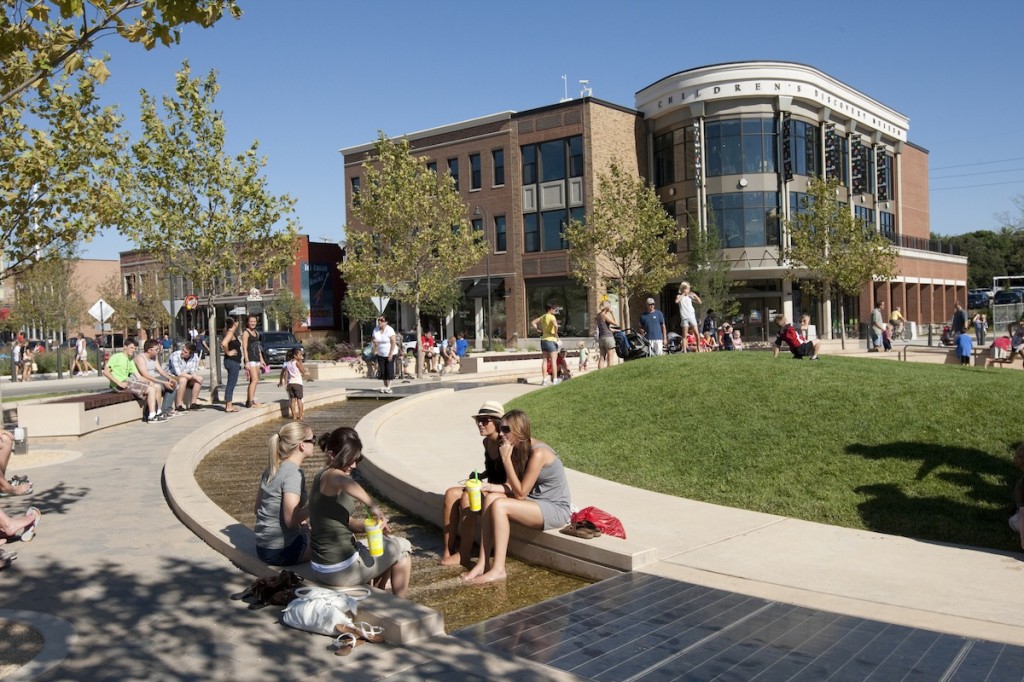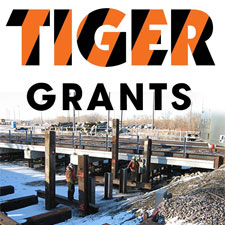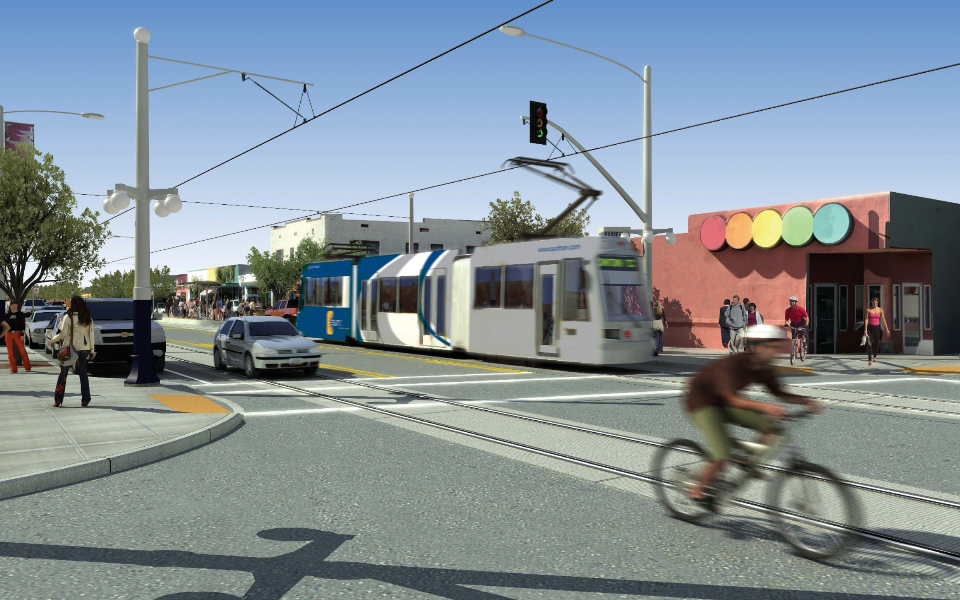 For me, when I hear the word "bipartisan", my first reaction is to brace myself to confront a piece of corporate mischief making being peddled under the excuse that there is some other piece of corporate mischief making that is even worse and this bad policy will stop ... or sometimes just delay ... that even worse policy from being implemented.
For me, when I hear the word "bipartisan", my first reaction is to brace myself to confront a piece of corporate mischief making being peddled under the excuse that there is some other piece of corporate mischief making that is even worse and this bad policy will stop ... or sometimes just delay ... that even worse policy from being implemented.
However, since the appeal came from Transportation for America, I was willing to keep reading and see what was in it:
Most taxpayers would agree that the level of government closest to the people should have more control over how transportation dollars get spent in their local communities. Yet local cities, towns and counties control less than 15 percent of all federal transportation dollars.If you think that needs to change, then stop what you’re doing and ask your representatives to cosponsor this critical, bipartisan bill. It would give local communities more access to federal transportation funds that they can invest in homegrown transportation plans and projects that they control.
Join me below the fold to have a look and a think about this proposal.
Setting Aside Federal Money for competitive Local Community projects
If there is a devil hiding in this then it would, of course, be found in the details.
The key to this proposed legislation is the setting aside of allocated Federal funds for competitive funding of local projects:
- 10% of the National Highway Performance Program for running the process and for grants
- at least 33% of National Highway Safety Improvement Program for grants
- at least 33% of the Congestion Mitigation and Air Quality Improvement Program for grants ~ if there are any "non-attainment" areas under the Clean Air act, the money must go to funding programs that are eligible under that act;
- at least 33% of the Surface Transportation Program; and,
- at least 33% of the Transportation Alternatives Program
Under the rules, funds that are already gives directly to metropolitan areas, allocated as urbanized area formula grants, or already distributes based on statewide competitive grant funding are excluded from the above amounts ... which is, in fact, a rule that pushes the local and/or competitive grant funding of projects up, since those are already 100% local and/or competitive grant funding of projects, so its 100% of one pile of money that is local and/or competitive grant funding, and then for the rest, the above percentages apply.
And note that except for the National Highway Performance Program funding which funds the process as well as grants, all of these shares are floors, which a given state can boost but not cut.
Of course, you can direct a state to set up a competitive grant project, but if it wanted to claw those funds back to its Road Building Empire State Transportation Department ... couldn't it just deny all the applications?
But there is no claw back allowed. If funds are not not allocated, or are allocated but not spent within five years of award, the funds go back into the pool of funds for competitive grants.
The third major question about the details is, who decides? The bill sets out membership criteria for the grant committee, which is:
- At least nine from three groups in equal numbers:
- At least three from the state's transportation department;
- At least three representing local governments (with provision for representation of small, medium sized and large local governments);
- At least three representatives of metropolitan planning organizations, councils of governments, and rural planning organizations.
- Nine representatives of:
- local chambers of commerce;
- "transportation management organizations, travel and tourism boards, economic development organizations, and other coalitions of employers and commerce";
- local air quality boards;
- state safety boards or local safety organizations;
- transit authorities;
- port authorities, if applicable;
- active transportation organizations;
- public interest organizations; and
- labor unions (note that unions and local chambers of commerce are on opposite ends of the list, which could be so they are well separated and don't get into an unseemly fight in the text of the legislation).
And similar to the funding set-asides, at least one representative of each type is required in the second set of nine public representatives if possible ... so while there wouldn't be a port authority representative in a state without any port authorities, a state can't refuse to appoint a representative of a labor union just because it doesn't want to (though the states without port authorities may be less common than you'd think, since that not only includes states with navigable rivers, but also places like my landlocked county in Northeast Ohio that has no recognizable port anywhere within its boundaries).
To be sure, I am sure there will still be much mischief in setting these grant panels up, but on the other hand, the alternative is for almost all of this money to be directed, often without any competitive scrutiny at all, by State departments of transportation that are almost always heavily influenced or completely captured by the road lobby ~ including the sprawl development interests that give them so much of their political clout.
How much money are we talking here?
 Since all of these allocations are in percentage terms, how much money we are talking about depends on how much funding is given to each of these programs. But lets look at the original 2014 authorizations for MAP-21:
Since all of these allocations are in percentage terms, how much money we are talking about depends on how much funding is given to each of these programs. But lets look at the original 2014 authorizations for MAP-21:
- $2,190m = $21.9b x 10% for the National Highway Performance Program
- $795m = $2.41b x 33% for the Highway Safety Improvement Program
- $736m = $2.23b x 33% for the Congestion Mitigation and Air Quality Improvement Program
- $3,333m = $10.0b x 33% for the Surface Transportation Program
- $271m = $820m x 33% for the Transport Alternatives Program
- ~= $7.3b total (or more if enough states elect to increase the funding)
Now, we know that there are projects out there that could use this money, since the $600m TIGER discretionary grant program received applications for $9.5b worth of projects. This is, in a certain sense, a response to the proposal to slash TIGER funding from $600m to $100m while zeroing out almost all of the really useful projects that TIGER was able to fund. And rather than playing pure defense, this is a proposal that goes on offense, substantially increasing the opportunity for competitive grant applications from local communities.
And it is the scale of the funding that is most important, here. With roughly $30 funding per capita, that means that a state like mine, Ohio, with a population of 11.5m and growing (just not so fast as some others) would be looking at a total pool of somewhere around $300m-$350m annually, under MAP-21 authorizations.
Now, to be sure, that is not the kind of money we need to be spending on infrastructure for carbon neutral, energy independent transport ... we ought to be spending something more like 70b annually, dedicated to carbon neutral, energy independent transport alternatives, and on top of that we ought to be spending $10b's more to bring our existing transport system infrastructure up to a state of good repair ... but its a big step up from TIGER grant funding, which itself was a step up from the kind of opportunities for development of community based transport alternatives.
So, what's the catch? It's bipartisan, there has to be a catch!
 As far as the Bi-Partisan status of the legislation, its being offered in the House by Representatives Davis (R-IL) and Titus (D-NV), and in the Senate by Senators Wicker (R-MS) and Booker (D-NJ). So it can't be written exactly as I would have preferred ... there has to be some concessions made here to attract what passes for moderate Republican support.
As far as the Bi-Partisan status of the legislation, its being offered in the House by Representatives Davis (R-IL) and Titus (D-NV), and in the Senate by Senators Wicker (R-MS) and Booker (D-NJ). So it can't be written exactly as I would have preferred ... there has to be some concessions made here to attract what passes for moderate Republican support.
However, one of the concessions compared to the TIGER program is something that I actually quite like. That is that the grants are awarded by state composed grant panels, rather than by the US Department of Transportation. It would seem that the reason this is a political concession is that rather than the US Secretary of Transportation cutting the cutting, you might have the Governor or head of the State department of transportation cutting the ribbon.
Indeed, the House Republican funding model for TIGER appears to be "Kill Due To Success", with this popular and effective program being rewarded for its success by a proposal by House Republicans to slash $500m from its $600m funding and eliminate almost everything useful about the program from the projects it is allowed to fund. Politically, that would seem to be a move to cut the funding for the program because it is working, and if it continues to work, the credit will largely accrue to the administration.
But this administration has fewer than three years to go, and with the House Republicans posing a serious threat of not passing a Transport authorization or appropriation, allowing the Highway Trust Fund to run out in advance of the midterms ... the fight over Transport funding could well see all of TIGER killed in any event.
And the establishment of competitive grant funding for community projects in each and every state is a superior solution in any event, given a large enough flow of funds to make the state totals worthwhile. Transportation for American coming up with a political concession that happens to be the superior transportation policy choice is, in my view, a very sound move.
The other area that appears to be part of the "bipartisan" part is in the selection criteria. The selection criteria will include projects that do one or more of the following:
- improve safety for all users of the transportation network;
- strengthen the contribution of a national freight network to the Nation’s economic competitiveness;
- promote multimodal connectivity;
- strengthen return on investment, particularly the impact on local economic development;
- improve access to jobs, sources of labor, schools, and opportunity;
- optimize, through better design and operation, the usage and efficiency of existing transportation facilities;
- improve the reliability of the transportation system of the United States;
- encourage innovation and the use of technology; or
- further the purposes described in the purpose section of the bill:
- (1) to increase the return on investment in the Nation’s surface transportation system;
- (2) to make the Nation’s surface transportation system more reliable, safe, and efficient by advancing innovative projects selected through State competitions;
- (3) to increase input from local government and stakeholders on projects receiving funding; and
- (4) to leverage Federal highway dollars further through in-State competitions.
Now, most of this is "bipartisan" in the old-fashioned sense of there being broad consensus that these are pretty sensible goals to pursue, but the "bipartisan" in the sense of concessions to specifically Republican talking points are in the factors that a state may consider (which, therefore means it also may not consider if it chooses not to):
- provide that special consideration in the approval of project applications is given to eligible projects that: maximize the amount of proposed project costs that can be borne by the applicant from non-Federal sources; or have prior significant Federal or non-Federal investment; and;
- give equal consideration to differences in the fiscal capacity of public eligible entities.
The first of these nested set of factors is the concession to Republican talking points: a state that so choose may give priority to programs based on how high a share of their funding they get from elsewhere. The final factor seems to me like is a concession to the Republican House strongholds in outer suburban, small town and rural areas, since it looks to me like it says (bearing in mind IANDL ~ I Aint No Damn Lawyer) that a state may at the same time have local community or transport authority's funding support be judged relative to the local community's tax base or transport authority's funding base.
Both Corporate Republicans and Radical Reactionary "Liebertarians" like language like the first part in transport funding, since it gives "Public Private Partnerships" under the pretense that public money is being used more effectively when it is used alongside private money. These "Public Private Partnerships" are all too often sleight-of-hand hidden hand outs, where the value over time of the rights, privileges and public funding granted to the private partner substantially exceeds the value of the funding it brings to the table. And after all, that should be no surprise, since why else would a private partner bring money to the table?
Except there is another reason that a private partner may bring money to the table, which is that the project itself is a net value creator, and the value that is received by the private partner is a share of the genuine return on the investment.
The thing is, there is no magic formula for ruling the first, "parasitic" PPP out of bounds and the second, "symbiotic" PPP in bounds. However, if a state panel is strongly biased toward the "parasitic" type of public-private partnership, at least under the proposed system, members of the general public can lobby local community leaders, transit authorities, transport advocate groups, public interest groups, labor unions, and (depending on the state) port authorities and various other interests with representation on the panel to stop doing that. Under the current system, most of this money is divided up in state legislative deals and, (sometimes in order to take it out of the reach of excessive interference by the citizenry) at the discretion of the Department of Transportation.
And the flip-side of the issue is that the process of winning support for local public and private funding leads to projects that have both broader and more entrenched local support, and this process results in a project that is more likely to succeed.
And as far as allowing a state to weight a local government or transit authority's contribution relative to its ability to pay ... this is a "don't throw me into the briar patch" concession. If a state elects to adopt this, this means that there will be projects from all manner of low tax base outer suburban, small town and rural communities being proposed, and the best of them getting a fair hearing.
And, politically, this is something that advocates of a sustainable transportation system would very much like to see happen, because spreading the benefits of these projects across the landscape is one of the ways that we can reduce the partisan polarization over transport alternatives.
Now, I do want to make clear that none of this is arguing that a "broadly bi-partisan" approach is going to be sufficient. It is not. Sooner or later, we are going to have to make a push to carbon neutral, energy independent transport. When we do, there will be entrenched vested interests that will prefer their near term individual benefit to the long term continued survival of the United States as a going concern. And those entrenched vested interests will at the very retain their control on one of the two main political parties.
So if we even reach the point of being able to fight the main fight ... it will be a bruising partisan fight for the possibility of the continued survival of the United States, against entrenched vested interests willing to risk our nation's economic and/or political collapse. No pussy-footing around with "broad bi-partisan consensus" will pass muster if we can reach that point, where there is one prospective contending party of government willing to fight for the continued survival of our nation.
However, so far as "bipartisan compromise" can take us, my initial impression is that this proposed legislation is a step in the right direction, and so, unless some serious "gotcha" is unearthed that Transportation for America failed to see, I'm suggesting this legislation for your serious consideration.
Conclusions and Conversations
The Sunday Train does not end at the end of the essay. Rather, the end of the essay is just the beginning of the conversation.
And, as always, any topic in sustainable transport is on-topic in the Sunday Train. So feel free to talk about CO2 emissions reduction, energy independence, suburban retrofit and reversing the cancer of sprawl over our diverse ecosystems, or the latest iPhone or Android app to map you bike ride. Whatever.
On this particular topic, what are your initial reactions to increasing the amount of Federal transportation funding that goes to fund local projects awarded through competitive grant applications? Do you think this is something we should put increased emphasis on, as this bill proposes? And what any other thoughts, whether on this bill or not, do you have on the coming transportation funding fight?
Comments
So, do we have what it takes to get Super-TIGER passed?